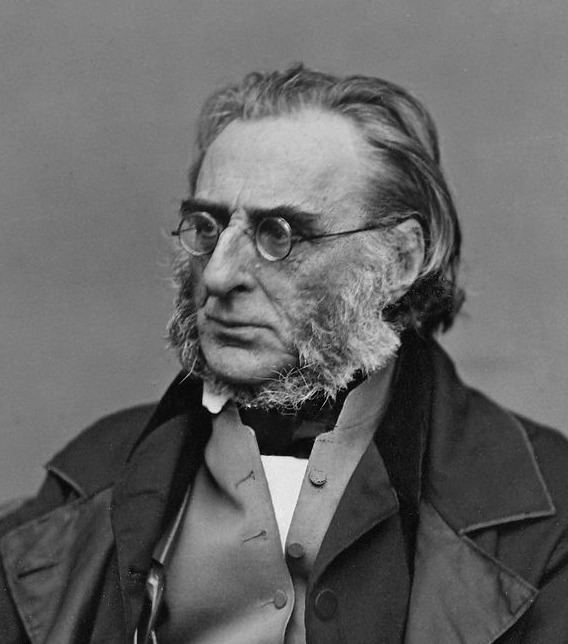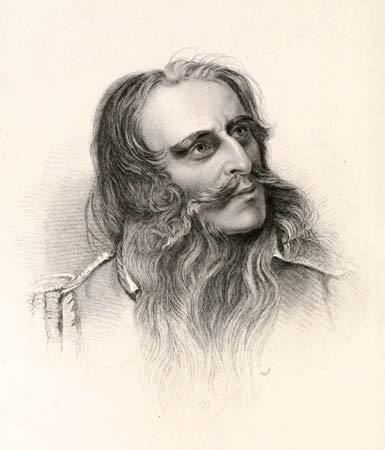Name Charles Napier | Preceded by New office | |
 | ||
Governor-General The Lord EllenboroughSir Henry Hardinge Books Defects, civil and military, of the Indian government Parents George Napier, Lady Sarah Lennox Siblings William Francis Patrick Napier Cousins Charles James Fox, Lord Edward FitzGerald Similar People George Napier, George Thomas Napier, Lady Sarah Lennox, Hoshu Sheedi, Sir James Outram - 1st Baronet | ||
Robert Gets His Sir Charles James Napier Question Wrong | The Chase
General Sir Charles James Napier, GCB (10 August 1782 – 29 August 1853), was a general of the British Empire and the British Army's Commander-in-Chief in India, notable for conquering Sindh in what is now Pakistan.
Contents
- Robert Gets His Sir Charles James Napier Question Wrong The Chase
- Charles James Napier
- Genealogy
- The Peninsular War
- Service in India
- Views on subduing insurgencies
- Memorials
- References

Charles James Napier
Genealogy
He was the eldest son of Colonel (the Honourable) George Napier and his second wife, Lady Sarah Lennox, with this being the second marriage for both parties. Lady Sarah was the great-granddaughter of King Charles II. Napier was born at the Whitehall Palace in London, and he received part of his education at boarding school in Celbridge, Ireland. Napier joined the 33rd Infantry Regiment of the British Army in January 1794, and decided to become a career soldier.
The Peninsular War

Napier commanded the 50th (Queen's Own) Regiment of Foot during the Peninsular War in Iberia against Napoleon Bonaparte. Napier's activities there ended during the Battle of Corunna, in which he was wounded and left for dead on the battlefield. Napier was rescued, barely alive, by a French Army drummer named Guibert, and taken as a prisoner-of-war. Nevertheless, Napier was awarded an Army Gold Medal after he was returned to British hands.
Napier recuperated from his wounds while he was being held near the headquarters of the French Marshall Soult and afterwards Michel Ney. On March 21, 1809, a British sloop approached Corunna with a letter for the commandant of the city, requesting information about the fate of Napier on behalf of his family. After an agreement between Michel Ney and Napier, the latter was released on a convalescence leave at home for three months, under parole to return to Michel Ney's quarters wherever he was on the first of July 1809.

Napier volunteered to return to the Iberian Peninsula in 1810 to fight again against Napoleon in Portugal - notably in the Battle of the Coa, where he had two horses shot out from under him, in the Battle of Bussaco, in the Battle of Fuentes de Onoro, and in the Battle of Badajoz (1812) (the second siege of Badajoz) in Extremadura, Spain, in which he was a lieutenant colonel in the 102nd regiment. For his deeds at Bussaco and at Fuentes de Onoro, Napier won the silver medal with two clasps. Napier returned to England and became the General Officer Commanding of the Northern District in England in April 1839.
Service in India

In 1842, at the age of 60, Napier was appointed Major General to the command of the Indian army within the Bombay Presidency. Here Lord Ellenborough's policy led Napier to Sindh Province (Scinde), for the purpose of quelling the insurrection of the Muslim rulers who had remained hostile to the British Empire following the First Anglo-Afghan War. Napier's campaign against these chieftains resulted in victories in the Battle of Miani (Meanee) against General Hoshu Sheedi and the Battle of Hyderabad, and then the subjugation of the Sindh, and its annexation by its eastern neighbours as the Sind Division.

His orders had been only to put down the rebels, and by conquering the whole Sindh Province he greatly exceeded his mandate. Napier was supposed to have despatched to his superiors the short, notable message, "Peccavi", the Latin for "I have sinned" (which was a pun on I have Sindh). This pun appeared in a cartoon in Punch magazine in 1844 beneath a caricature of Charles Napier. The true author of the pun was, however, Englishwoman Catherine Winkworth, who submitted it to Punch, which then printed it as a factual report. Later proponents of British rule over the East Indians justified the conquest thus: "If this was a piece of rascality, it was a noble piece of rascality!"
On 4 July 1843, Napier was appointed Knight Grand Cross in the military division of the Order of the Bath, in recognition of his leading the victories at Miani and Hyderabad.
Napier was appointed Governor of the Bombay Presidency by Lord Ellenborough. However, under his leadership the administration clashed with the policies of the directors of the British East India Company, and Napier was accordingly removed from office and returned home in disgust. Napier was again dispatched to India during the spring of 1849, in order to obtain the submission of the Sikhs. However upon arriving once again in India, Napier found that this had already been accomplished by Lord Gough and his army.
A story for which Napier is often noted involved Hindu priests complaining to him about the prohibition of Sati by British authorities. This was the custom of burning a widow alive on the funeral pyre of her husband. As first recounted by his brother William, he replied:
"Be it so. This burning of widows is your custom; prepare the funeral pile. But my nation has also a custom. When men burn women alive we hang them, and confiscate all their property. My carpenters shall therefore erect gibbets on which to hang all concerned when the widow is consumed. Let us all act according to national customs."Napier remained for a while as the Commander-in-Chief in India. He also quarrelled repeatedly with Lord Dalhousie, the Governor-General of India. The source of the dispute was Dalhousie's behaviour on India's north-west frontier. Dalhousie had requested repeated punitive raids against villagers who had not paid taxes. Napier was opposed to these tactics but accompanied a column of East India Company troops under Sir Colin Campbell and Punjab troops under George Lawrence. The Punjab troops were not under Napier's command and began burning villages on Lawrence's orders. ‘This was as impolitic as it was dishonourable to the character of British soldiers,’ protested Napier, ‘yet no power was entrusted to me, and I had been sufficiently cautioned against interfering with the Punjaub civil authorities.’.
Napier returned home to England for the last time. He was still suffering with physical infirmities which were results of his wounds during the Peninsular War, and he died about two years later at Oaklands, near Portsmouth, England, on 29 August 1853, at the age of 71. However his quarrel with Dalhousie was not over. In his posthumously published 'Defects, Civil and Military of the Indian Government' (Westerton, 1853) he detected and condemned the growing superciliousness of the English in India towards the Indians; 'The younger race of Europeans keep aloof from Native officers … How different this from the spirit which actuated the old men of Indian renown,' he wrote. He proposed that British officers should learn the language of the natives and that native officers be appointed as ADCs and Companions of the Bath. ‘The Eastern intellect is great, and supported by amiable feelings’, he wrote, ‘and the Native officers have a full share of Eastern daring, genius and ambition; but to nourish these qualities they must be placed on a par with European officers.’
When revolt broke out in 1857, Napier's 'Defects' was hailed as a prophetic work which correctly identified many of the seething tensions in the sub-continent. The problem was as one of his contemporaries observed ‘Had he made his representations with sober moderation, eschewing all offensive exaggeration, his warnings and suggestions would have commanded attention. Instead they were pooh-poohed as the emanations of a distempered mind.’
Napier's former house is now part of Oaklands Catholic School of Waterlooville. Napier died on 29 August 1853 and his remains were buried in the Royal Garrison Church in Portsmouth.
Views on subduing insurgencies
General Napier put down several insurgencies in India during his reign as Commander-in-Chief in India, and once said of his philosophy about how to do so effectively:
The best way to quiet a country is a good thrashing, followed by great kindness afterwards. Even the wildest chaps are thus tamed.which may help explain why he felt rebellions should be suppressed with such brutality.
He also once said that:
the human mind is never better disposed to gratitude and attachment than when softened by fear.An implementation of this theory would be after the Battle of Miani, where most of the Mirs surrendered. One leader held back and was told by Napier:
Come here instantly. Come here at once and make your submission, or I will in a week tear you from the midst of your village and hang you.He also mused that:
so perverse is mankind that every nationality prefers to be misgoverned by its own people than to be well ruled by another.However, he also displayed what for the time, were liberal attitudes. ‘War is detestable and not to be desired by a nation’, he wrote. ‘It falls not so heavily upon soldiers – it is our calling; but its horrors alight upon the poor, upon the miserable, upon the unhappy, upon those who feel the expense and the suffering, but have not the glory.’
Memorials
In 1903, the 25th Bombay Rifles (which as the 25th Regiment of Bombay Native Infantry had formed part of Napier's force in the conquest of Sindh) was renamed the 125th Napier's Rifles. Since amalgamated, it is now the 5th Battalion (Napier's) of the Rajputana Rifles.
A bronze in honour of Sir Charles Napier by George Gamon Adams (1821–1898) surveys from its plinth the southwest corner of Trafalgar Square, while a marble stands in the Crypt of St. Paul's Cathedral. In his bronze, he is shown bareheaded, in military uniform, with his cloak thrown back. His left hand is grasping his sword by the scabbard and raised above his waist, while his right, extended, holds a scroll symbolic of the government awarded to Scinde during his tenure of office. The monument was erected in 1855–6 by means of public subscriptions, the most numerous contributors being private soldiers.
His remains lie in the now-ruined Royal Garrison Church, Portsmouth. His tomb is immediately outside the west door to the church. A loose plaque in the church is thought to have indicated the burial place of Sir Charles, inside what is now the west wall.
The city of Napier in the Hawke's Bay region of New Zealand is named after Sir Charles Napier. The suburb of Meeanee commemorates his victory in the Battle of Miani.
The city of Karachi in Sindh (Pakistan) earlier had a Napier Road (now Shahrah-e-Altaf Hussain), Napier Street (now Mir Karamali Talpur Road) and Napier Barracks (now Liaquat Barracks) on Shara-e-Faisal. In the port area, there is also a Napier Mole. In Manora, the St. Paul's Church, erected in 1864, is a memorial to Napier. There is also Residential area in Quetta named as Napier Lines after his name.
The Napier Gardens in Argostoli on the Greek island of Kefalonia are named after him.
Some ten pubs in England are named after him, either as the Sir Charles Napier, or the General Napier.
Karachi Grammar School named its second-oldest house "Napier" after Sir Charles Napier (the oldest House is named Frere after Sir Henry Bartle Frere).
The city of Ambala in Haryana (India) has a road named after him in the cantonment area. 54, Napier Road, the official residence of the Commissioner Of Police of Ambala is on this road.
